Science educational resources at Las Cienegas National Conservation Area relate to water, wildlife, plants, and citizen science.
Follow a link below or scroll down for all resources.
Water
Las Cienegas National Conservation Area is special because it is one place in our wild landscape where there is water year-round.
Wildlife
Because of Cienega Creek’s perennial flow, the area is home to many animal species that depend on the precious desert water.
Plants
Las Cienegas is home to five distinct vegetative communities.
Citizen Science
Involve students in monitoring projects to aid scientific research.
Water
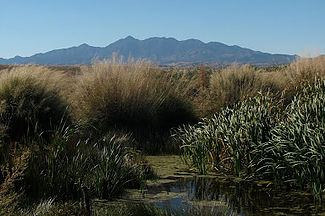
A cienega at Las Cienegas National Conservation Area.
Photo courtesy BLM.
What does cienega mean?
Student Reading Resources
- An overview of the significance of Cienega Creek.
- Arizona Riparian Council’s educational resources about riparian habitat and desert waters
- Mining and Cienega Creek – The New York Times article about mining and water in Arizona
- Arizona Daily Star article about how drought is affecting Cienega Creek.
- A brief report by the Sonoran Institute about conserving land around Cienega Creek.
- A report that summarizes years of monitoring data and examines the water level trend for Cienega Creek.
- A PowerPoint presentation “Water Resource Trends in the Cienega Watershed” created by Pima Association of Government staff, presented June 8, 2013. Great for having students learn to read tables and graphs and interpret data.
- Arizona’s Riparian Areas by the UA’s Cooperative Extension
Government Agencies and Nonprofits That Focus on Local Water Issues
- Pima Association of Governments Watershed Planning Resources
- Pima County – Water and Riparian Resources
- Cienega Watershed Partnership
Water Education Resources
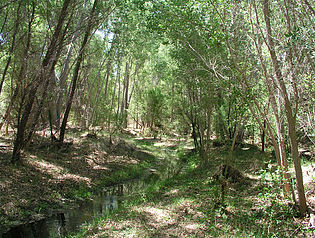
Riparian habitat at Las Cienegas National Conservation Area.
Photo courtesy BLM.
Watershed Education Resources
- Crumple a watershed lesson
- Sample curriculum: Watershed Connections Guidebook – from Canada
Water Resources – General
- AZ Know Your Water- A Consumer’s Guide to Water Sources, Quality, Regulations, and Home Water Treatment Options (downloadable booklet)
- AZ Well Owner’s Guide
- Layperson’s Guide to Arizona Water
- Virtual Tour of Lower Cienega Creek at Marsh Station
Hydrology of Cienega Creek
Wildlife
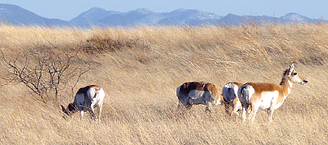
Pronghorn antelope in the Cienega Watershed.
Pronghorn Antelope
- Background reading from the Pronghorn Antelope Foundation
- Brief articles written by participants in the Antelope Foundation’s Youth and Conservation project at Las Cienegas
Black-Tailed Prairie Dogs
- A clear and concise article written for a University of Arizona environmental writing class about the prairie dog project.
- The Arizona Game and Fish Department’s webpage on the black-tailed prairie dog reintroduction project
- A five minute video documenting a 2010 BTPD release into a new colony start in AZ
- A story that aired in May 2013 on Arizona Public Media documenting the reintroduction project
Yellow-Billed Cuckoo
- An article from the USGS about the importance of preserving the cuckoo’s habitat
Grassland Birds
Birds are important indicators of an ecosystem’s health. Learn about the research being conducted locally in these presentations:
- Winter Bird Monitoring and Citizen Science
- Groundwater and Bird Monitoring at Las Cienegas
- How Birds Respond to Mesquite Habitats
- Ten Years of Research on Grassland Birds
Learn more about birds and grasslands research from the National Audubon Society’s Appleton-Whittell Research Ranch
Southwestern Willow Flycatcher
- A site from the USGS with basic information about the Southwestern Willow Flycatcher
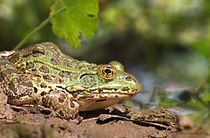
Chiricahua leopard frog.
Photo by Dennis Caldwell.
Chiricahua Leopard Frog
- Resources from the FROG Conservation Project
- A video from the annual Science on the Sonoita Plain symposium about the FROG projet
Gila Topminnow
- An overview by Arizona Game and Fish about the endangered topminnow and pupfish
- A 2011 news segment about restoring Topminnow to local waterways
- A teaching resource for a 2007 documentary about the restoration of Fossil Creek in Central Arizona
- Native Acquatic Species of the Gila River Basin in Arizona and New Mexico (U.S. BLM)
- Videos from the Bureau of Reclamation about the plight of native fish
General Resources
- Coloring pages of endangered species in Pima County
Plants
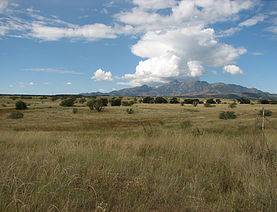
Grasslands of the Las Cienegas.
Photo courtesy BLM.
Las Cienegas is home to a great diversity of plant life. A large expanse of intact rare desert grasslands grow near other interesting species that thrive in the area’s riparian corridor.
Grasses and Grasslands
- A website providing an overview of Arizona’s grasslands
- A printable guide for identifying native grasses
- A chapter about a giant sacaton grass restoration project on the Cienega Creek Preserve
- Listen to this audio clip by naturalist and local legend Petey Mequity as he talks about giant sacaton
Cottonwoods
- Watch a video about the cottonwoods at the San Pedro Riparian National Conservation Area
- Teachingmaterials for the video can be found here
Mesquite Trees
- Watch these short videos about mesquite trees and their relationship to the grasslands.
Citizen Science
Take advantage of the following “citizen science” resources to assist with research in the Cienega Watershed and surrounding region:
- Contribute your drought observations at Arizona Drought Watch: http://azdroughtwatch.org/dirs/
- Follow your regional drought status with the ADWR Drought Program
- Contribute your Local Precipitation measurements: Rainlog.org
- See your local watercourses’ daily flow data: PC Alert http://alert.rfcd.pima.gov/perl/Pima.pl
- See the history of Cienega Creek flow length in the County Preserve
- Learn to restore your land and make it drought resilient with rainwater harvesting and erosion control measure with Watershed Management Group: http://watershedmg.org/
- Track wildlife migration with Sky Island Alliance http://www.skyislandalliance.org/
- Track changes to seasonality of blooms, sprouts and migrations with the National Phenology Network: https://www.usanpn.org/
- Learn how to make a frog friendly pond: Local Frog Conservation Project
- Hike and Camp with Leave No Trace Ethics
More Information
For additional information, please contact us.
